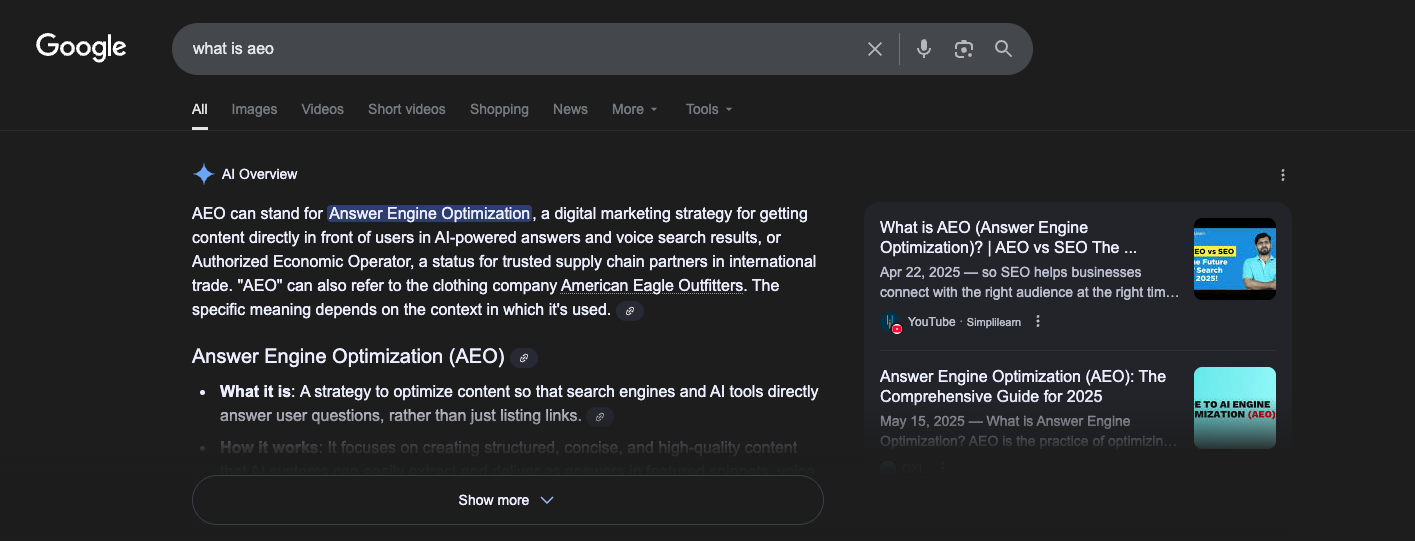AEO — What it is, why it changes the game, and how to get ready for it.
Whether or not you use artificial intelligence tools in your daily life, you’ve probably noticed in recent months that some search engines, like Google Chrome, for example, now display an answer to your question at the top of the page, even before the sponsored results.
This first answer, called the “AI Overview,” is powered by Google’s artificial intelligence, Gemini, and is the direct result of a new trend in the world of SEO: AEO.

AEO, short for “Answer Engine Optimization,” is the set of practices that make your content directly usable by answer engines and conversational assistants (Google SGE, Bing/Copilot, Perplexity, ChatGPT, etc.). Instead of aiming to attract a click to your page, the goal is for the AI to reuse (and cite) your content to directly answer a user’s question.
In other words: instead of hoping that a user clicks on your site to find the answer, you structure and write your content so that the AI tool can already provide the right answer — and ideally cite you as the source.
But how do you get there? What can you do to make artificial intelligences cite you? And what role does SEO play in all of this?
While e-commerce websites have continued to grow in importance over the past decade, showcase or informational sites have lost ground, giving way to social networks, video platforms, and influencers.. However, that trend has been reversing at full speed since November 2024. That pivotal date marks the public launch of ChatGPT. The reason is simple: artificial intelligences still don’t cite influencers or social media posts. They rely instead on so-called “reliable” sources — websites whose information can be verified. The race for visibility is back on, and it’s fiercer than ever.
Information about this new way of driving visibility online is still murky. Released only in bits and pieces, it often leads people to confuse AEO with SEO. While both aim for visibility, there are some key differences:
SEO seeks the click.
AEO seeks the answer — and sometimes the reuse of your text.
The techniques overlap (structure, quality, relevance), but AEO places greater emphasis on structure, precision of the answer, and immediate clarity.
Le AEO answers a question.
LLMs (Large Language Models) — another name for artificial intelligences such as ChatGPT, Gemini, Perplexity, Claude, etc. — are trained to provide concise, direct answers. They favor content that:
The direct consequences are:
We refer to “zero-click” when the user gets the answer directly on the results page or through an assistant, without clicking any link. It’s the direct outcome of an AI-generated response — or of the “AI Overview” we mentioned earlier in this article.
The impacts of zero-click are significant:
The right approach: don’t choose between SEO and AEO — do both. Keep pages that convert when users click, and create pages designed to be reused by answer engines.
The right approach isn’t to choose between SEO and AEO: it’s to do both.
It’s important to keep pages that convert when users click, while also creating pages designed to be reused by answer engines.
AEO is still in its early days, nothing is set in stone, and we’re likely to see many changes and adjustments in the months and years to come. Just like traditional SEO, two things are clear: early adopters will be the big winners, and those who lag behind will struggle.
Adapting your website for AEO will bring you:
AEO doesn’t replace SEO, it complements it.
Businesses that learn how to write for AI while still being useful to humans will gain visibility, authority, and commercial efficiency.